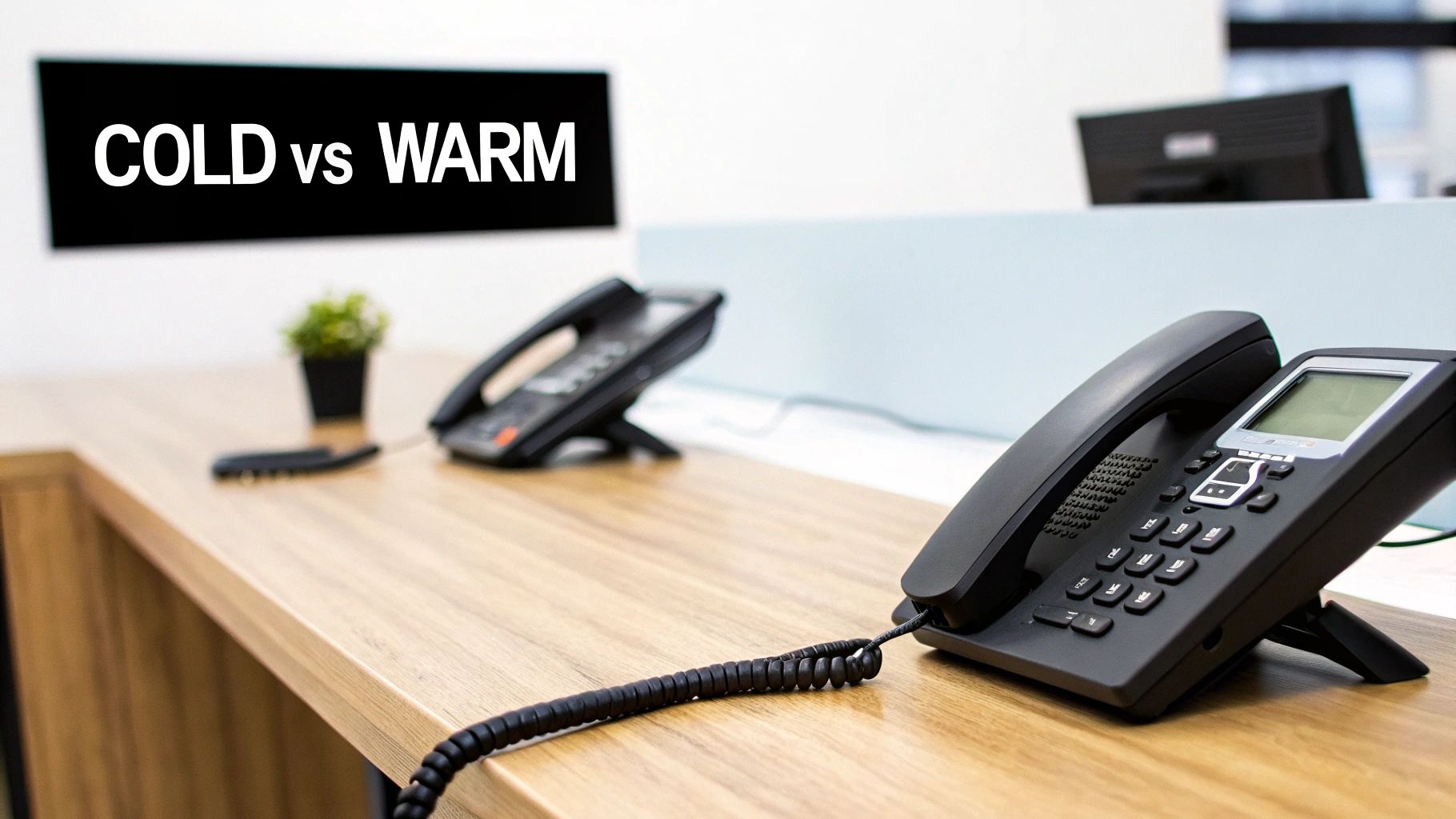The core difference really boils down to one thing: context. A cold transfer is like tossing a file onto someone's desk without a word—it’s an immediate, unannounced handoff. A warm transfer, on the other hand, is a coordinated handoff. The first person gives the next a quick rundown before making the connection, ensuring the customer doesn't have to start from scratch.
When a customer calls your business, the way their call gets passed between team members says a lot about your company. Getting a handle on the difference between a cold transfer vs a warm transfer is the first step toward creating a call management strategy that actually works. One method puts agent speed first, while the other prioritizes a smooth ride for the customer.

Let's break down how each one works in the real world. A cold transfer—sometimes called a "blind transfer"—is exactly what it sounds like. An agent sends a call straight to another person or department without any introduction.
The person on the other end answers completely in the dark, with no idea who's calling or what they need. This forces the customer to explain their whole situation all over again. It’s fast for the person doing the transferring, but it can be a really jarring experience for the caller.
A warm transfer, however, involves a quick chat between your team members before the customer is connected. The first agent puts the caller on a brief hold, gets the next person on the line to explain the issue, and then patches the customer through. This small step makes a huge difference, ensuring the next agent is prepped and ready to jump right in.
A warm transfer signals to the customer that your team is collaborative and values their time, turning a simple handoff into a positive brand touchpoint.
To make things even clearer, let's look at the core differences side-by-side. This table really highlights the trade-offs you're making between speed, customer effort, and internal collaboration.
As you can see, the choice isn't just about process; it's about the kind of experience you want to create for both your customers and your own team.
The choice between a cold and a warm transfer does more than just move a call from A to B—it directly shapes how a customer feels about your business. It's the difference between being treated like a hot potato and a valued person whose time matters. While a cold transfer might feel faster for your agent, it can be a massive source of frustration for the person on the other end of the line.
Having to repeat an issue multiple times is a universal pain point. When a call is transferred blindly, the customer is forced to start from scratch, retelling their story to someone with zero context. This process doesn't just waste their time; it makes them feel unheard and unimportant, quickly souring their perception of your company.
The negative impact of a cold transfer is real and measurable. It essentially hits the reset button on the customer's journey, erasing any progress they made with the first agent. This not only disrespects the customer's time but also makes it much more likely they'll just hang up out of sheer frustration.
Call centers that rely heavily on cold transfers tend to see higher rates of call abandonment and more repeat calls. In fact, warm transfers can increase customer satisfaction scores by approximately 20-30% compared to their colder counterparts. On the flip side, centers that frequently use cold transfers report up to a 25% higher rate of call abandonment because the first contact doesn't resolve anything. You can find more insights on why warm transfers make a difference in this detailed breakdown of call transfer methods. The data shows a clear link between the transfer method you choose and your customer's loyalty.
A warm transfer communicates, "We're working together to solve your problem," while a cold transfer often says, "You're no longer my problem." The message your customer receives depends entirely on the process you choose.
A warm transfer, on the other hand, creates a supportive and seamless experience. When the first agent takes a moment to brief the next one, it sends a powerful signal to the customer: your team is collaborative, organized, and focused on them. This simple act turns a potentially frustrating handoff into a genuinely positive interaction.
The new agent can greet the customer by name and immediately get to the heart of the issue, showing both competence and care. This approach doesn't just solve problems more efficiently; it builds trust and reinforces a positive image of your brand. By investing just a few extra moments in a warm handoff, you are actively enhancing the customer experience. You're turning a routine call into a real opportunity to strengthen that customer relationship. Ultimately, this thoughtful process proves to customers that their issue is being handled by a unified team that's committed to finding a solution.
When you’re weighing a cold transfer vs. a warm transfer, the debate often lands on operational efficiency. If you're looking at it from a purely numbers-driven perspective, the cold transfer seems like the obvious winner for a busy call center. It lets the first agent wrap up their side of things in a flash, which directly shaves time off their Average Handle Time (AHT).
For high-volume centers obsessed with getting agents back in the queue, this immediate time-saving is incredibly tempting. The call gets passed on, the agent’s timer stops, and they’re free to grab the next one. But focusing on this one metric is often a trap, one that creates bigger headaches down the road.

That short-term gain from a lower AHT? It’s usually wiped out by a surge in repeat calls. When a customer gets transferred blindly, they have to start their story all over again. That's frustrating for them and dramatically increases the chances of the call being mishandled. The result is a customer who hangs up and calls right back, inflating your overall call volume and straining your team.
The efficiency of a cold transfer is an illusion. It simply shifts the time burden from the first agent to the entire system, increasing overall customer effort and operational costs.
This is exactly where the warm transfer, despite taking a bit longer upfront, proves its strategic value. By investing an extra minute or two to brief the next agent, you can dramatically improve the performance indicators that actually matter.
While a warm transfer does nudge the initial agent's AHT up slightly, the long-term payoff is huge. The biggest win is in First Call Resolution (FCR)—a vital metric for both customer happiness and your bottom line. When an issue gets solved on the first try, it completely eliminates the need for expensive follow-up calls.
The stats tell a clear story. Cold transfers might cut AHT by 10-15%, but they often lead to a 30% spike in repeat calls. On the flip side, a warm transfer might increase AHT by 5–10%, but it can slash repeat calls by as much as 20%. What’s more, call centers that prioritize warm transfers often report a 15% higher Net Promoter Score (NPS).
Ultimately, a smart transfer strategy depends on what you’re trying to achieve. You need to understand how each method affects your most important business goals. For a deeper look at what to track, check out our guide on the https://www.myaifrontdesk.com/blogs/8-key-call-center-metrics-examples-for-2025. Of course, none of this matters without the right technology, which is why understanding the advantages of modern VoIP systems is also a critical piece of the puzzle.
Knowing the difference between a cold and a warm transfer is one thing, but applying that knowledge in the heat of a customer call is what really separates good service from a great one. The choice isn't about which method is inherently "better"—it's about which one is strategically right for that specific moment. This requires a clear-cut protocol that empowers your team to make the best choice on the fly.
Some situations are just straightforward. They prioritize speed over a detailed backstory. In these moments, a cold transfer isn't just acceptable; it's the smartest move. It keeps the lines moving and respects everyone's time when a lengthy handoff is unnecessary.
A cold transfer is your go-to for simple, low-stakes interactions. If a caller has a basic question that another department can answer without needing any prior conversation history, a direct handoff is the most logical and efficient move.
Think of it like this:
The goal of a smart cold transfer is to connect a caller to the right resource with minimal friction when the context of their call is simple and self-contained.
This decision tree visualizes the core logic perfectly: is the request complex or urgent?

As the chart shows, how complex and urgent a caller's need is should be the main driver behind your choice. It's all about matching the handoff style to the situation.
While cold transfers certainly have their place, some situations absolutely demand the personal touch of a warm transfer. Trying to use a cold transfer in these high-stakes moments can seriously damage customer trust and lead to major frustration. In these scenarios, context is king.
A warm transfer becomes absolutely essential in cases like these:
To make this crystal clear for your team, here’s a quick guide to help them decide which transfer to use in common situations. Having a straightforward protocol like this removes the guesswork.
Ultimately, building a clear and effective transfer protocol empowers your team to deliver a consistently positive experience, no matter who picks up the phone.
For years, the choice between a cold transfer vs. warm transfer has felt like a compromise. Do you prioritize speed or the customer experience? It’s a classic business dilemma. But what if you didn’t have to choose? Artificial intelligence is completely rewriting the rules, turning the simple act of handing off a call into a smart, data-driven interaction.
AI-powered systems can now handle both transfer types with a level of insight and accuracy that just wasn't possible before.

This shift takes the guesswork out of the equation. An AI front desk doesn't just route calls; it analyzes them, making sure every caller lands in the right place on the very first try, no matter which transfer method is used.
Even the notoriously abrupt cold transfer gets a major intelligence boost from AI. Instead of a human agent making a split-second guess, an AI receptionist uses natural language processing to instantly understand why the customer is calling. It pinpoints the caller's intent and routes them to the exact right person or department—all without any human intervention.
This is what we call a "smart" cold transfer. It keeps the speed customers expect but adds a layer of precision that prevents the number one cause of frustration: being sent to the wrong place. The process is still lightning-fast, but it’s guided by intelligent analysis, not a hopeful guess.
Where AI really shines, though, is in elevating the warm transfer. This new, tech-assisted approach blends the empathy and nuance of a human conversation with the sheer data-processing power of AI. The result is a nearly perfect handoff.
Here’s a quick look at how it works:
This simple process is a game-changer. The second agent gets the full picture in seconds. They can greet the customer by name and get straight to the solution without forcing them to repeat their story. It’s the ultimate combination of efficiency and personal touch.
This technology is fundamentally reshaping customer interactions. For businesses trying to figure out where this new wave of automation fits, comparing an AI vs a human receptionist offers a ton of valuable insight. AI isn't just checking tasks off a list; it's creating a smarter, more connected communication workflow that helps everyone—the business, the employees, and most importantly, the customer.
Alright, let's move from theory to practice. Kicking off a better call handoff process starts with a hard look at your current system. You need to audit your existing workflows to figure out exactly where customers are hitting roadblocks.
This initial deep dive is what helps you truly understand the difference between a cold transfer vs warm transfer in your day-to-day operations. The goal here isn’t just to make a few tweaks; it’s to build a clear, documented protocol that takes all the guesswork out of the equation for your team.
Your new protocol should spell out precisely which situations call for which type of transfer. Once you've got those guidelines nailed down, it's time for some serious team training. Role-playing is your best friend here—it lets your team practice everything from simple questions to high-stakes escalations in a safe environment.
Great training is only half the battle; your team needs the right tools to back them up. An integrated CRM is non-negotiable. It ensures that customer data and the conversation history travel with the call, giving the next agent the full picture before they even say hello. This is the absolute backbone of a successful warm transfer.
And for businesses ready to really dial in this process, learning how to use call transferring workflows with an AI front desk can be a massive leap forward. It’s a fantastic way to standardize your new strategy without a ton of manual effort.
The final piece of the puzzle is measurement. A strategy without metrics is just a suggestion. You cannot improve what you do not track.
Finally, you need to know if it's actually working. Set up some key performance indicators (KPIs) to track the impact of your changes. A few metrics you'll want to keep a close eye on include:
When you're trying to figure out the difference between a cold and a warm transfer, a lot of practical questions come up. The goal isn't just to move calls from one person to another; it's to make every handoff feel deliberate and genuinely helpful. Let's tackle some of the common sticking points.
The single biggest mistake is forgetting about the customer's time. While you're busy briefing the next agent, that customer is just sitting on hold, and every second of silence makes them more likely to get frustrated.
A good warm transfer is all about setting expectations. You need to tell the customer exactly who they're being transferred to, why it's necessary, and give them a rough idea of how long it's going to take. If you leave them hanging in the dark for too long, you completely undo all the goodwill you were trying to build, making the extra effort a waste of time.
Not at all. There’s a time and a place for everything. Cold transfers are perfectly fine for simple, low-stakes issues where the next person doesn't need any backstory. For instance, if someone calls sales but just needs to confirm a billing address, a quick, direct transfer to the billing department is the most efficient way to handle it.
The trick isn't to get rid of cold transfers entirely. It's about using them strategically—only when the request is straightforward and the next agent doesn't need a detailed history to solve the problem.
You'll know your strategy is working when the numbers tell you it is. The best way to measure success is to track a few key performance indicators (KPIs) before and after you make the change. A solid strategy should lead to obvious improvements in both your team's efficiency and your customers' happiness.
Keep an eye on these metrics:
Ready to perfect your call handoffs with intelligent automation? My AI Front Desk uses AI to execute flawless smart transfers, ensuring every caller gets to the right person on the first try. Discover how you can improve customer satisfaction and operational efficiency at myaifrontdesk.com.
Start your free trial for My AI Front Desk today, it takes minutes to setup!








